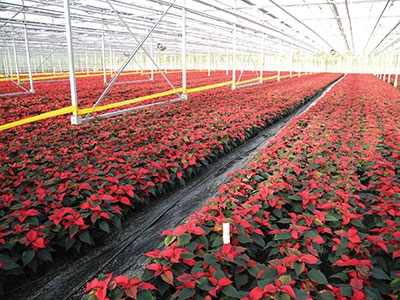
Features
Business
Trends
Poinsettias, the European way
The market wants more sustainable production using less energy and peat moss and fewer chemicals
November 28, 2014 By Stefan Reiner
 A greenhouse full of 12 cm pots.
A greenhouse full of 12 cm pots. Nov. 28, 2014 — Many growers and retailers think of poinsettias as a commodity with rather high production costs and low margins with little to no room for error. Still, it is one of the most important and largest indoor flowering pot plant crops.
“It is and always was a red poinsettia, nothing has changed,” some might think.
In fact, much has changed in the past 10 years and even more when looking further back.
The most recent changes include consolidated production and modern cultivars, enabling growers to change the way they grow and use poinsettias today.
Yes, they are still mostly red, and it is one of the few crops where the colour mix hasn’t changed much over the years. In fact, sales of red are becoming stronger again. White is a distant second, and the rest trail well back.
With all the hype about different colours and shapes, if history tells us one lesson, it is that red is choice number one despite all consumer surveys where specialties may rank at the top but usually are not picked at the point of sale.
Poinsettias and Christmas, in most European countries, are closely tied together. The sales period has changed a bit over the years. The trend to earlier sales was strong for a while, but recently it has returned to the more traditional sales window closer to Christmas. This has quite an impact on the variety mix, as fewer early varieties are needed – rather more varieties with a long sales window to allow flexibility.
WEATHER A MAJOR FACTOR IN SALES
Weather has quite an influence on poinsettia sales, but, overall, sales in Europe have been quite stable. After losses years ago, the situation has stabilized also thanks to the “Stars for Europe” campaign (www.stars-for-europe.com).
Despite their seasonality, poinsettias remain the number two flowering indoor pot plant behind orchids. However, they are only a distant second, with orchids still gaining ground.
Germany is the largest consumer market for poinsettias in Europe, and besides German production, the Netherlands and Denmark especially are exporting large quantities to Germany.
TREND IS TOWARDS SMALLER PRODUCT SIZES
A clear trend over the past years has been toward smaller plant formats. The so-called standard product is a 13 cm pot with five to seven bracts and about 35 cm in overall height. This standard format is more and more being replaced with smaller more compact formats like 12 cm and 10.5 cm midis (branched) and 6 cm minis (straight-up).
Each of the three formats currently makes up about a third of the total market with only two per cent (from four per cent the years before) specialty sizes, such as larger containers, trees and so on.
There are two main reasons for the change to smaller formats. One of them is the market and especially the way poinsettias are sold today.
More and more poinsettias are sold via discounters, grocery supermarkets, and DIY outlets, asking for a more competitive product in top quality.
The smaller plant formats allow growers to grow more plants per square metre and enable the shipping of more plants at once. Many growers say they need, for example, Minis in a certain percentage on a truck to make shipping worthwhile.
Larger plant formats and specialties are sold mostly via garden centres and florists.
The second reason has to do with the way poinsettias are used today. Many are now centrepieces on tables or in decorative mixed planters, so plants need to be short enough not to block the view.
Minis are usually decorated and used as gift items or just purchased during grocery shopping. In fact, most 6 cm minis are sold via grocery supermarkets and discounters.
Midis (branched poinsettias) are mostly sold by discounters and DIY outlets.
Poinsettias, like the Christmas tree, are becoming more and more part of a season celebration. People moving to Europe, despite their origin or beliefs, celebrate Christmas and use poinsettias. The poinsettia is now part of the winter season, a decorative item, and younger generations are catching on. An old-fashioned product is in fashion again thanks to new ideas on how to use poinsettias and their broad availability.
The trend to smaller formats as part of the indoor “winter season decoration” will continue. For 2014, it is expected that Minis will continue to increase, Midis will be stable, and the standard format as well as specialty formats will continue to decrease.
Research demonstrates that the baby boomer generation currently buys the majority of poinsettias. However, the younger generations are starting to buy more poinsettias, while older generations are buying fewer of them. It will be on us to continue realizing the trends and needs of today’s consumer, thereby ensuring poinsettias a spot in homes during the winter season.
RETAILERS INSISTING ON MORE SUSTAINABLE PRODUCTION
The latest challenge is a more sustainable production using fewer chemicals and less energy and peat. Large grocery chains have started to test for chemical residue in poinsettias and request a certified production (social and environ-mental).
The entire supply chain and the variety have become more and more important again, but this time from a different angle. Varieties must allow for sustainable production and offer flexibility at the same time so growers can keep up with the market. The trend to local production will continue. With the latest actions by environmental organizations targeting pot plants and production practices, everyone in the chain must adapt and overcome hurdles for a bright poinsettia (horticulture) future.
In the future, consumers will still buy mostly red poinsettias but in smaller to medium plant formats coming from a sustainable supply chain locally finished. Consumers want a “green” (sustainably grown) poinsettia.
Stefan Reiner is the head of Product Management at Selecta and can be reached via s.reiner@selectaklemm.de.
Print this page


